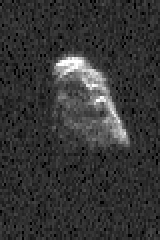On June 27, asteroid 2011 UL21 made a relatively close encounter with Earth, passing our planet at a distance of 6.6 million kilometers (4.1 million miles), roughly 17 times the average distance from Earth to the Moon.
While this encounter wasn’t close enough to worry about, it did give astronomers a chance to get a close look at the object. Doing so can help us learn more about such asteroids, as well as narrow down their orbits, allowing us to know if they will pose further risks to the planet in the future.
“The term ‘potentially hazardous asteroid’ (PHA) is a precise formal definition that refers to asteroids larger than approximately 140 meters. [459 feet] which can reach a distance of 7.5 million km [4.6 million miles] from Earth,” Gianluca Masi, astrophysicist and scientific director of the Virtual Telescope Project, said in a statement before the flyby. “In other words, only the largest asteroids capable of coming close enough to our planet are designated as PHAs, which do not mean they will hit Earth, but still require better monitoring.”
During this year’s flyby, NASA’s Deep Space Network’s Goldstone Planetary Radar closely followed 2011 UL21, imaging it seven times as it flew by at 25 kilometers (16 miles) per second. This was the first chance that NASA had to image an asteroid with radar, and when they did, they discovered that the asteroid was actually a binary system. The asteroid has its own moon, orbiting at a distance of about 1.9 miles (3 kilometers).
“About two-thirds of asteroids of this size are thought to be binary systems, and their discovery is particularly important because we can use measurements of their relative positions to estimate their relative orbits, masses and densities, providing key information about how they may have formed, Lance Benner, JPL’s principal scientist who helped lead the observations, said in a statement.
The moon can be seen at the bottom of these radar images.
NASA/JPL-Caltech
During the approach, NASA discovered that the asteroid was roughly spherical. Before radar imaging, there was uncertainty about the size of the object, with estimates suggesting it could be as small as 1.7 km and as large as 3.9 km (1.05 to 2.4 mi). After radar imaging, NASA puts its size at nearly 1 mile (1.5 kilometers) wide, slightly smaller than expected.
It’s actually been quite a busy week for the radar system, which observes space objects by sending out radio waves and then receiving the reflected signal back to the same antenna. On June 29, the second object – discovered only on June 16 – came much closer, passing within 295,000 kilometers of Earth. That’s just over three-quarters of the average distance between the Earth and the Moon, which is pretty close to the approach of the asteroid tentatively named 2024 MK.

Asteroid 2024 MK, hurtling through space.
Image credit: NASA/JPL-Caltech
“For these observations, scientists also used DSS-14 to transmit radio waves to the object, but used Goldstone’s 114-foot (34-meter) DSS-13 antenna to receive the signal that bounced off the asteroid and returned to Earth,” NASA explained. .” The result of this ‘bistatic’ radar observation is a detailed image of the asteroid’s surface, revealing concavities, ridges and boulders about 30 feet (10 meters) wide.
The asteroid’s orbit was slightly altered by Earth’s gravity, shortening its 3.3-year orbit around the Sun by about 24 days. Discovered by the NASA-funded Asteroid Terrestrial-Impact Last Alert System (ATLAS) just 13 days before its closest approach, the asteroid is classified as potentially hazardous. However, calculations of its orbit show that it poses no threat to Earth in the foreseeable future.